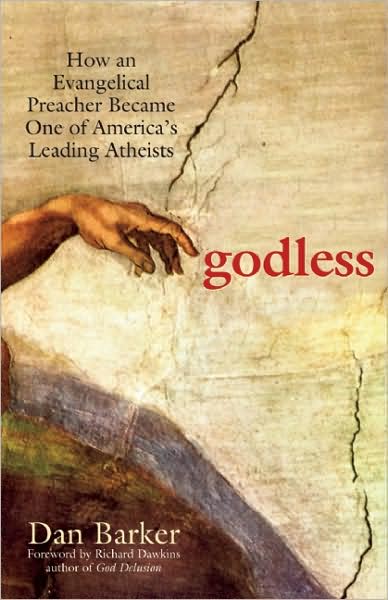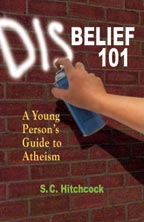In a bold-face plagerism of my wife’s idea, I here offer my thoughts on the latest books I’ve read…

1. Godless (by Dan Barker)
Okay, first of all: great cover! Second, what’s with that subtitle? I think I should make a list of books that don’t fit the theme of their subtitle. Barker spends the first chapter of his book detailing his life as a bible-thumping missionary/preacher/musician, then devotes chapter two (and only chapter two) to a brief synopsis of how he became an atheist. In fact, it was so brief, I can’t even tell you exactly why he felt the need to examine his faith, or what, exactly, caused him to wake up from theism.
In the remaining 18 (or so) chapters, Barker jumps from one godless topic to another: in one chapter, he tells of court cases his foundation (the Freedom From Religion Foundation) has battled to uphold separation of church and state. In another chapter, he humorously points out the implausibility of an ominpotent and omniscient god. These chapters are fun, informative reading, and they offer the theist LOTS to think about (and give free-thinkers plenty of responses!). I just found it odd how disconnected the chapters were. It’s especially weird considering the books begins as a biography – a genre that typically weaves its chapters together very tightly.
Bottom line: B
 2. Why Don’t Penguins Feet Freeze? (compilation)
2. Why Don’t Penguins Feet Freeze? (compilation)
I purchased this book in a desperate attempt to find something to read before begininning the 4+ hour trip home from our vacation last week. I’m not sure what to call this type of book (Q and A? General knowledge?), but this kind of book is usually a safe bet with me. I’ve read dozens of books like it, wherein a question is asked and then answered. They’re fun to read, because they’re usually questions that only briefly pop into one’s mind during the day, but when you see the question in print, you think, ‘yeah, I have always wondered that’. Just listing off some of the book titles I’ve read will give you an idea of the kind of questions that are answered: How Does Aspirin Find a Headache? Why Do Men Fall Fall Asleep After Sex? When Did Wild Poodles Roam the Earth? The cliche (regardless of author or publisher) seems to be to name the book after one question found in the book. I find this stupid, as it gives browsers the impression that there’s a whole book dedicated to (in this case) penguins’ feet. The best books like this that I’ve read are David Feldman’s Imponderables series, Cecil Adam’s Straight Dope Series, and the book What’s the Difference? This book, I have to say, is the worst of the bunch. The thing that makes the other books great is the research that goes into them: industry and scholastic professionals are contacted, experiments are performed, and old history is dug up. Not so this book – this book’s authors spent no time doing such pesky work. They merely posted questions online, and selected the best (and often conflicting) responses for each question. In fact, I can’t even tell you the answers to any question in the book, because any info I may have retained is suspect due to the fact that, no sooner did I read one answer, then I read the next answer which pointed out why the first one was wrong. If you want to read stuff like this, just type your question into Yahoo and see what sort of responses you get from various, um, yahoos.
(When I got back to Minnesota, I returned this book. The ‘authors’ didn’t deserve my money.)
Bottom line: F
 3. Disbelief 101 (S.C. Hitchcock)
3. Disbelief 101 (S.C. Hitchcock)
Well, if you’re a friend of mine, chances are you won’t learn anything new from this book. And that’s not an indictment of the book, no, it’s a comment on your age. Disbelief is intelligently designed to appeal to the tween/early-teen crowd, and it does a superb job.
The book is divided into several brief chapters that build on each other, explaining the absurdity of believing in god(s). The book endeavors to shine light on the flaws of all religions but, as the author notes, ends up dwelling on the three ‘great’ monotheisms. This only makes sense, as the book was prublished & is being marketed in the US.
Hitchcock beautifully addresses concerns and fears a young person may have regarding casting aside faith. He even adivses youths on how to deal with their rational thinking should they happen to live in a household where dissenting opinions are forbidden. This struck a chord with me – had I the audacity to pick up this book when I was, say, ten, the first three pages are probably would have had time to read before my Watchtower-sponsored guilt kicked in and told me to put the book back on the shelf. But the author, knowing this sort of behavior is rampant amongst fundies, spends those three pages calming his readers & telling them it’s okay to set such ideas aside until free of well-intentioned care-givers who would likely not understand.
Hitchcock makes the argument that, while phyiscal abuse is not tolerated in this country, mental abuse gets a free ride: punch your kid in the face, and the cops will come to your door. Tell them that god will burn them forever in hell if they don’t accept Jesus into their heart, and everyone applauds your faith. Good point.
Oh, BTW, the best part of the book is the hilarious illustrations.
Bottom Line: A
 4. The Invention of Hugo Cabret (Brian Selznick)
4. The Invention of Hugo Cabret (Brian Selznick)
Holy (insert expletive of choice)! This was one phenomenal book!
I first spotted this book at Border’s a few weeks ago & thumbed through it. I was surprised to see such a thick book (it’s over 500 pages) in the children’s section. It looked intriguing, but I didn’t have the cash to buy it. Fast forward to the mad-dash while on vacation (see above) and I contemplated buying it again. Alas, I didn’t want to bring such a big book in an already crowded car. So I finally picked it up from the library on Friday, and I had finished reading it by Saturday afternoon.
Did I mention this is an awesome book? The story unfolds partly in text / partly in pencil drawings. It begins, like a film, by drawing back the curtain on Paris, circa 1930, and tracking across the city, finally zooming in on a young orphan who lives behind the walls of the train station. He fends for himself while hiding a couple of big secrets. His spars with a local vendor he steals from (sorry for the spoiler, but, come on, it can’t be that revealing to learn that a homeless orphan has to steal food), befriends a young girl, and, well, I can’t really say anymore than that without ruining anything. As the story progesses, the threads of Hugo’s life begin to come together, and the ending – full of surprises – is poingiant, satisfying, and just plain beautiful. The book ends with an appendix (how many juvenile novels end with an appendix?)…which I actually read. Yeah, that’s right, the book was so good, I read the appendix. And it, in turn, offered several websites that I visited to find out more.
If you read this book, don’t do what I did (I flipped through the book before reading it, and, since much of the story is told in pictures, I had an inkling of what was going to unfold); just open to the first page, and begin reading.
Suspense! Pathos! Beauty! Humor! I can find no defect in this work of art.
Bottom line: A
